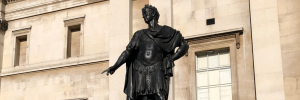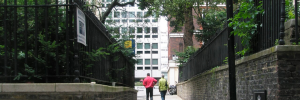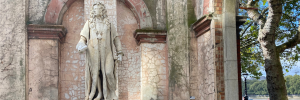Remember that the City of London used to be a walled city with the original walls built by the Romans in about 200AD. There were, of course, gates in the walls eg Ludgate, Bishopsgate, Aldgate. By the 13th century the boundaries of the City of London had extended west outside of the walls – to where the Royal Courts of Justice now stand. There was no proper gate at that point to check who was entering the City or to be able to extract taxes. So a rudimentary gate or bar was originally erected close to the Temple Church – within the English headquarters of the Knights Templar, and this gate came to be known as Temple Bar.
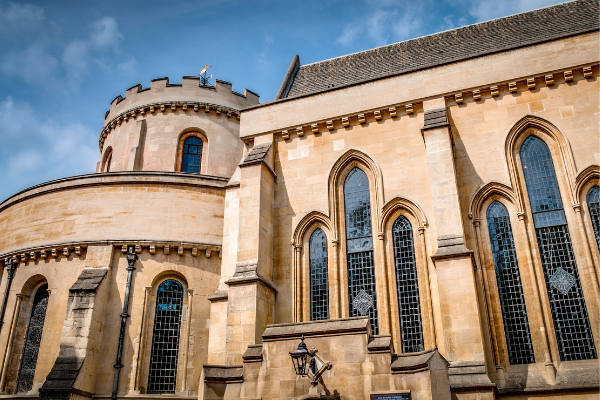
Over the centuries various wooden structures replaced the original bar. After the devastation of the Great Fire of London in 1666 there was a massive rebuilding programme in the City and although the existing structure had not been damaged it was thought a more impressive entrance to the City was needed at this point. The gate is attributed to Sir Christopher Wren who, it is thought, was commissioned to design it by the king, Charles II. It was completed in 1672. As well as being a thing of beauty the gate also has a royal message. The City of London was very much on the side of the victorious Parliamentarians in the English Civil War during which the king, Charles I, was captured, tried and executed in 1649. There was no monarch for 11 years until Charles II, son of the executed king, was invited back.
The new gate was a real statement that the royal family – the Stuarts – had returned. So as you entered the City of London from the City of Westminster you would see the statue of the king Charles II (on the right) and his executed father Charles I (on the left). On the other side of the gate are statues of James I of England (who was also James VI of Scotland), the first Stuart king, and his wife Queen Anne of Denmark. The gate was also used to remind anyone thinking of opposing the king’s authority what would happen to them as heads of executed “traitors” were exhibited on it until 1746.

Temple Bar was the last of the City’s gates to be removed. It was eventually decided to take it down as it was causing too much traffic congestion at the entrance to the City and was also in a bad state of repair. In just 11 days in 1878 it was dismantled. All the stones were carefully numbered and stored in a yard off Farringdon Road. Ten years later the stones caught the eye of Lady Meux who persuaded her husband, a wealthy brewer, to buy them and have the gate reconstructed as the gatehouse to the park of their country mansion -Theobald’s Park – in Hertfordshire. By coincidence, Theobald’s Park was previously the site of a palace belonging to James I, that first Stuart king who features on the gate.

Lady Meux was somewhat looked down upon by society – it was said she met her husband whilst working in a casino as a banjo-playing barmaid but she still managed to entertain celebrities, including it is believed, the Prince of Wales, in the room which still exists above the arch. In the early 20th century the park, excluding the gate, was sold to Middlesex County Council and for decades the gate stood in a neglected state.
In 1976 the Temple Bar Trust was established with the aim of saving the gate and fulfilling the 1877 resolution of the Court of Common Council (the name of the town council of the City of London) that it be rebuilt in the City. In 1984 the Trust acquired the gate for a mere £1 and gave it to the Corporation of London in 2001. It was dismantled again and re-erected as the entrance to Paternoster Square (just behind St Paul’s Cathedral) as part of its redevelopment, being officially opened in November 2004.
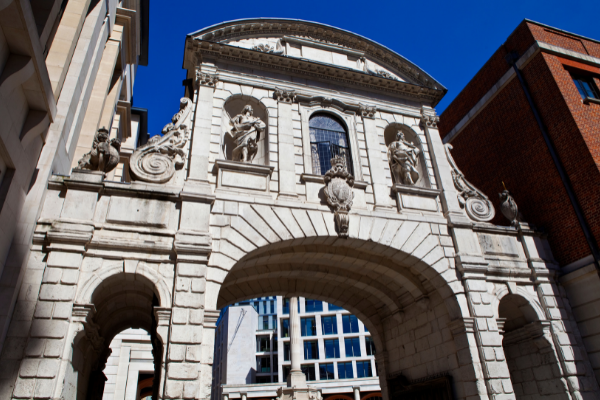
The cost of returning the gate to the City was just over £3m – the funding coming mainly from the Corporation of the City with donations from the Temple Bar Trust and several livery companies. Temple Bar as a location still exists in its original position and is now marked by the memorial in the middle of the road outside the Royal Courts of Justice. A giant dragon carrying the coats of arms of the City of London marks the entrance to the City. Designed by Horace Jones (also responsible for Tower Bridge, Smithfield, Leadenhall and old Billingsgate markets) it was unveiled in 1880. Continuing the royal theme it features statues of Queen Victoria and her son, the future King Edward VII – the last royals to pass through the gate in 1872.
Come on my Great Fire of London walk or our Heretics and Horrors walk and you will have a chance to admire Wren’s magnificent gate.

